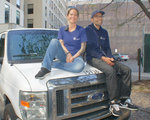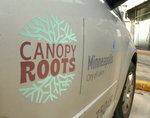


It has been a little more than four months since Minneapolis Office of Performance and Innovation launched the Behavioral Crisis Response (BCR) team’s pilot project, Canopy Roots. It is the nation’s first 911-based mental health first responder program.
BCR was started to provide crisis intervention, counseling and connection to support services as an alternative to police responders.
A report on the success and challenges of the project was presented to the city’s Public Safety Committee in late April, highlighting the responses that have occurred in the first quarter of operation. The city has a $6 million, two-year contract with the Black-owned Canopy Mental Health & Consulting based in Richfield for $6 million. It diverted some of its police funds into the pilot program.
BCR uses two vans, initially serving daytime shifts and now operating 24-7 weekdays. “There are two unarmed, highly trained mental health practitioners on each van,” said Gina Obiri, program manager for the performance and innovation office. She said that situations involving weapons, physical assault or medical emergencies are not directed to BCR.
100 CALLS A WEEK
Taylor Crouch-Dodson, another program manager, said the Canopy Roots BCR program has averaged 100 calls per week in its first quarter of existence. “There have been 1,650 calls, and BCR has been called to every neighborhood and precinct in the city,” he said.
The 911 operators are trained to dispatch the calls to the appropriate resource, whether it be BCR or the Minneapolis Police Department (MPD) or another agency. The calls are directed based on Problem Nature Codes (PNCs) and there are over 130 different PNCs. Calls for the BCR are divided into priority 1, a behavioral crisis response, or priority 2, a behavioral crisis response welfare check. Another call code is Person in Crisis (PIC).
“A PNC code can change throughout the nature of the call,” Crouch-Dodson explained. “A call may start as one thing and end up being another.” Overall, 88 percent of MPD calls have been diverted to BCR calls.
Regarding the fact that mental health crises are not limited to just weekdays, Crouch-Dodson emphasized that the project is hoping for full coverage on weekends as well, and more vans are needed.
“This is a pilot program,” he said. “Canopy Roots being able to staff so quickly is great.”
Minneapolis Office of Performance and Innovation Director Bryan Smith said that time is required to get the job descriptions out for the mental health professionals and to train them and the 911 operators. “We are serious about getting the right people to do this,” he said.
POLICE POSITIVE ABOUT BCR
In his report to the committee, MPD Deputy Chief Eric Fors said that anybody who has worked with the public recognizes the crises out there. “Law enforcement wants that deeper level of understanding,” he said. “The feedback from the rank and file has been very positive. They have generally asked when BCR will be expanding.”
He noted, “Because of the dangerousness of a call, it may require a police response. But when we arrive we may call BCR. It’s sometimes not clear until we get there that it’s a mental health call.” He said repetitive calls for help are often sent to embedded social workers. “There is a facility at 1800 Chicago Avenue that is staffed by county social workers, and it is a place where we can voluntarily bring people.”
Joni Hodne, assistant director for 911, said her agency was able to build the training program when the pilot project began and help the BCR team figure out the best training for them. “We went slowly because we had to teach how the first responder system works, talking on the radio and how to keep the public safe and our responders safe.”
She said the 911 call takers are highly trained and received additional training through the Mental Health Foundation to strengthen their ability to take a call and determine who is best to send. “It’s a job they do every day,” she said. “They decide what is suitable and safe for the BCR team to go into.” She said there are often more calls than they have vans or people to respond to from the BCR team, but the public needs a response. “So, we have to take calls and turn over to the MPD,” she said.
“As the program continues to grow and people request BCR specifically, it is going to be more difficult,” she continued. “We can’t say we cannot provide service. We work very closely with Canopy and its team, with their training program to get out on the street and with mental health.”
CALLS FOR ADVICE AND ASSISTANCE
Hodne said repeat callers are treated as first-time callers. “We do not want to put any past judgment on them, so we treat them with the same care and dispatch BCR every time.”
Crouch-Dodson inserted that the vast majority of BCR calls are for advice or assistance; the second-most number of calls are regarding individuals who are gone by the time the van arrives. The third highest number of calls, according to him, are for individuals seeking voluntary transportation to places that will help them remain stable.
“Embedded social workers are being used as follow-up,” said Candace Hanson, program director of BCR. “They have instructed us to call them after a crisis has been resolved, should additional help be needed. We consult as a team and strategize about what is available.”
Hanson said the goals of the response may be to treat in place and to provide the least intrusive intervention. “Those goals may be at odds with each other, and we may need to lead the individual to a different safe location,” she said.
A BCR call may be resolved in different ways, according to Hanson. “It can be emotional de-escalation, where we reduce the intensity of the situation. We can recycle education, giving community members information about mental health, connecting them to services and resources. We can make appointments, asking them where they might have gone before. Or we can guide folks, using their natural supports that are already intact. We can guide them through a panic attack.”
The great success in working with the MPD was something BCR had not expected, but Hansen said their relationship has been very positive. “It’s been very professional, and we have resolved (any issues) through conversation and collaboration,” she said. “Working with 911 dispatch has also been a big success for the program.” Hansen added that the Canopy BCR pilot program has gotten a very warm reception from the community. She said another positive is how much the BCR staff really love their work.
She admitted there are still challenges, with gaps remaining in the mental health system. But BCR is a work in progress. “Gathering information and data is particularly challenging,” she noted. “When someone is in crisis, that individual is not always the best historian.”
The BCR team is also hoping for a better relationship with Hennepin County.
“In building this, Hennepin County and Hennepin Emergency Medical Services (EMS) were at the table the whole time, about two years,” director Smith said. “It goes back to a misconception that if we came into existence, they would be replaced. But there’s enough work for everybody.”
He said, “EMS takes exception that we have designed a model that does not require police, and they have not been able to shed that as part of their policy. They could help us by having those conversations at a higher level more consistently so everyone understands what BCR is.”
‘BEST JOB I COULD ASK FOR'
Hansen said the BCR is looking for participants who are flexible, safety-minded but not fearful, and have a passion for working with the community. They are trained in de-escalation, CPR, detoxification, communication with each other, safety measures in the field and how to work with radios and computers.
“We ask them how Canopy can help them find their own journey to wellness,” Hanson said. “We set time aside after every shift to debrief. We give them opportunities to sit down with a supervisor after a tough call. And after a really tough call, we don’t have them jump into another one.”
Two responders gave their own feelings about the Canopy Roots project.
“Being able to come to the scene and have a recipient not trust who we are, but slowly see the wall start to fall is the highlight of being a responder,” one worker said.
“I had been waiting for something like this,” said another. “It’s the best job I could ever ask for. Every day is a good day to go to work.”
3 comments on this item Please log in to comment by clicking here
Lisaswan
This program sounds very much like the former COPE Program which was the co responder program, which was a branch of COPE. It sounds like it is suited well for calls where a person is needing that immediate transport to a shelter or to the ER. However the it is not clear on how there can be meaningful follow up with given different agencies. Other cities such as Brooklyn Park are doing alternative response programs which include regular follow up and EMS responding with a social worker when needed. Calls can be complicated, this is a start, but is more of a piece meal approach. I'm not seeing much in the way of clinical training as well. It does not very comprehensive or cohesive. It sounds good on the surface, but when you look deeper it, there are flaws.
Sunday, June 26, 2022 Report this
MinnieHaha
It sounds like a wonderful and very helpful program. But why on earth is it taking funding away from the police department, and not funded by health departments? They are dealing with mental health issues, and not law enforcement. Their funding should be separated.
Sunday, July 17, 2022 Report this
jsenkiw
This program IS NOT an alternative to police! This is a good program, but as others have noted this is a repackaged program that existed as COPE!
This came about because the council wants to push this as their alternative to MPD “public health based public safety “
Nothing new here..
Sunday, August 7, 2022 Report this